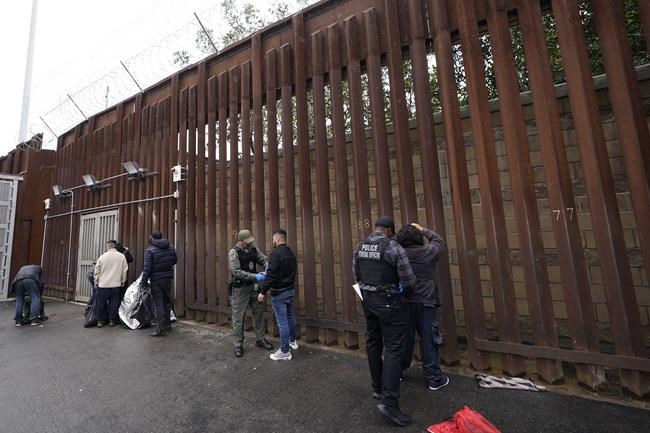WASHINGTON (AP) —
The Biden administration will open migration centers in Guatemala and Colombia for asylum seekers heading to the U.S.-Mexico border, in a bid to slow what’s expected to be a surge of migrants seeking to cross as pandemic-era immigration restrictions end, U.S. officials said Thursday.
The migration centers are part of an intense effort to try to prevent thousands of people from making the often-dangerous journey to the southern border when the restrictions end May 11.
But it is unclear whether the processing centers and other measures, including expedited processing for asylum seekers and crackdowns on human smuggling networks, will do much to slow the tide of migrants fleeing from countries marred by political and economic strife.
The Biden administration, under attack by Republicans eager to paint the border as wide open under his leadership, has repeatedly warned that the end of the pandemic-era immigration restrictions does not mean that migrants should try to come to the U.S. as they've also sought to open other avenues for migration.
Immigration has vexed Biden throughout his presidency, with top GOP leaders hammering him as soft on border security and immigrant advocates, saying he’s abandoning humanitarian efforts with stricter measures meant to keep migrants from coming illegally.
The topic isn’t going away, as he announces a 2024 reelection reelection bid, Biden is trying to strike a balance that could be difficult to achieve, particularly if crowds of migrants end up in border facilities as the restrictions end. The administration has also repeatedly pointed to Congress, saying it has been unable to come to an agreement on comprehensive immigration reform.
In a call with reporters, three senior administration officials detailed the migration centers, as well as other steps the administration was taking.
So far, centers will be located in Colombia and Guatemala, with other countries to be announced in the coming weeks, the officials said. They spoke on condition of anonymity ahead of the public announcement.
Prospective migrants would be able to go to the centers instead of coming to the border and get information on applying to become a refugee or other immigration options to either the United States or other countries.
The centers would be run by international organizations. Prospective migrants would be able to make an appointment on their phone to visit one of the centers, according to a fact sheet also released by the Department of Homeland Security.
The immigration restrictions date back to the beginning of the coronavirus pandemic when the Trump administration invoked a rule — known as Title 42 — which allowed border officials to quickly expel migrants without letting them apply for asylum.
Since March 2020, migrants have been expelled from the country more than 2.8 million times using Title 42.
Republican-leaning states have fought to keep the restrictions in place, arguing that their states will face increased costs like education from a surge in migrants if it’s lifted. The Biden administration initially kept the rule in place but barring any last-minute court decisions, it looks increasingly like May 11 will mark the end of the use of Title 42.
Administration officials have said without any other measures in place, they expect the number of migrants encountered at the southern border daily to rise to as much as 13,000 people a day.
But many immigration advocates say Title 42 actually gave migrants a perverse incentive to try repeatedly to enter the country because there were no repercussions if people were expelled. So, advocates argue, it’s unclear what will happen when Title 42 goes away, and the U.S. goes back to using immigration regulations that actually penalize someone who gets expelled.
Under the administration's plan, people who come illegally will also be swiftly removed and barred from re-entering the country for at least five years and would not be able to apply for asylum, according to the fact sheet.
It also says that families will be removed if they don’t meet the requirements for asylum, and the administration is stepping up efforts to keep track of families, including GPS monitoring and strict curfews.
But the administration stopped short of detaining families until they can be removed from the country — a step that would likely have caused a massive outcry among immigration advocates and some of the president's supporters.
The administration is also expanding access to an app where migrants can apply for asylum at a U.S. port of entry. And officials are creating a new reunification process for families from El Salvador, Guatemala, Honduras and Colombia that will allow vetted migrants with family in the U.S. to come legally.
Officials are also working to double the number of refugees from the Western Hemisphere. The administration additionally says it’s working with Colombia and Panama to curb migration through the Darien Gap.
Biden administration officials announced in early April a plan to work with both countries to shut down migration through the Darien Gap, with the U.S. providing intelligence gathering to dismantle smuggling rings operating in the dense jungle.
Already, U.N. groups are warning that 100,000 people have already made the dangerous crossing through the Darien Gap between Colombia and Panama, and that the number of migrants making the crossing could hit 400,000 by the end of this year. That would represent a huge increase from the 250,000 migrants estimated to have crossed the roadless, jungle-clad route in 2022.
Rebecca Santana And Colleen Long, The Associated Press


